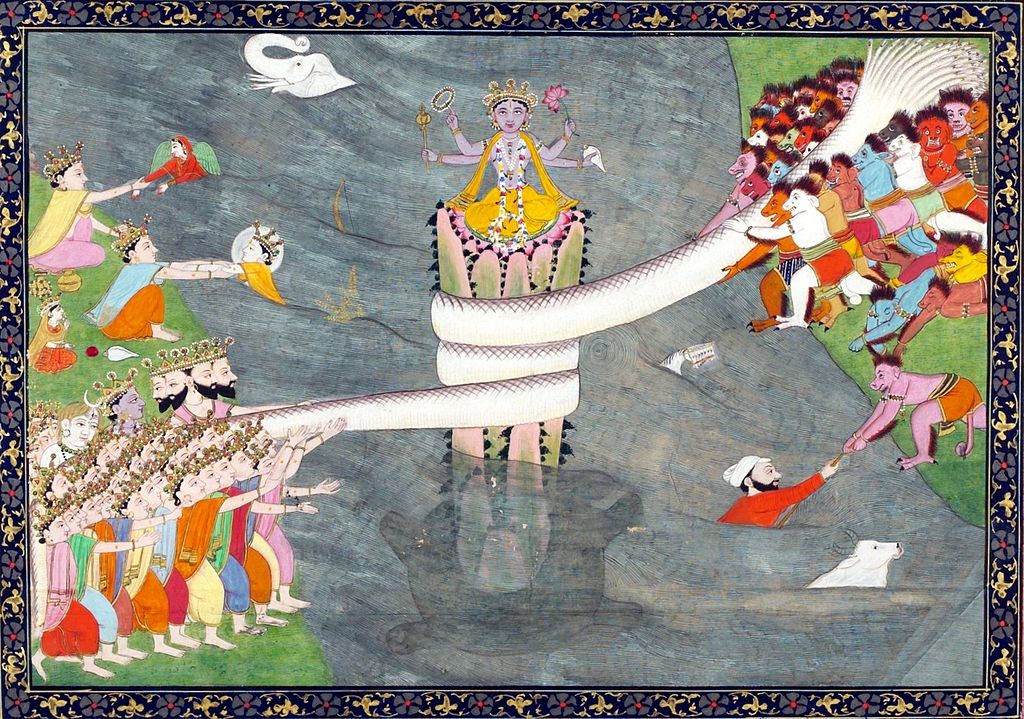According to Bhagavata, outcome of the churning of Ksheerasagara is Halahalam (terribly destructive poison), Amrita (nectar) with Dhanvantari (physician of Gods), Lakshmi (Goddess of Riches), Jyestha (Goddess of Poverty), Chandra (the Moon), a white elephant named Airavata, a horse named Uchchaisrava, Kalpavriksha (the tree that yields whatever is desired).
The Churning of the Cosmic Ocean (the Milky Way) is told in several ancient texts, notably in the Valmiki's Ramayana and in the Mahabharata.
Some relationships between the milk ocean and Goloka, the planet of Krishna may be found. Krishna is the same as Vishnu, who lives in a white castle on the ocean of milk and on other hand, Krishna is the same as Vishnu, but He lives on Goloka, a planet of cows (Sanskrit: "Go" - cow, "Loka" - world).
Other milky oceans are the yoghurt ocean, and the ghee ocean. These oceans are representative of the meaning that Absolute Truth is also sweet and wonderful - it suggests that humans not only live on Earth with a salt water ocean only, but also that there are other oceans like the sweet water ocean among these 7 oceans that humans may aspire to live in.
The material world is compared to the ocean of fault, especially in Kali-Yuga, so a way to go out of this matter is to enter the ocean of bliss - in the eternal world of Vaikuntha. The supreme planet in that ocean of Truth is Goloka, though only a few persons out of thousands and thousands may come to the conclusion of Absolute Truth and may subsequently live on this planet of cows, where the milk ocean exists.
In Hindu cosmology, the Ocean of milk (kṣīroda, kṣīrābdhi or Kṣīra Sāgara) is the fifth from the center of the seven oceans that surround loka or directional space and separate it from aloka or non-directional space. It surrounds the continent known as Krauncha.
In Hinduism, the devas, (gods) and asuras, (demons) worked together for a millennium to churn the ocean and release Amrita the nectar of immortal life. It is spoken of in the Samudra manthan chapter of the Puranas, a body of ancient Sanskrit legends.It is also the place where Vishnu reclines over Shesha Naga, along with his consort Lakshmi.
Hindu mythology also contains a story about the churning of the Cosmic Ocean in order to obtain Amrita - the nectar of immortal life. At the suggestion of Vishnu the gods, (devas) and demons (asuras) churn the primeval ocean in order to obtain Amrita which will guarantee them immortality.
To churn the ocean they used the Serpent King, Vasuki, for their churning-string. For a churning pole they use Mount Mandara placed on the back of a Great Tortoise - the Kurma Avatar of Vishnu. As the gods and demons churned the sea, a terrible poison issued out of its depths which enveloped the universe.
The devas and asuras approach Shiva who took the poison into his throat and swallowed it. Shocked by his act, Goddess Parvati strangled his neck and hence managed to stop it in his neck and prevent it from spreading. However, the poison was so potent that it changed the colour of his neck to blue, thereby earning him the name of Neelakanta (blue-throated one).
When the Amrita finally emerged along with several other treasures the devas and asuras fought over it. However Vishnu in the form of Mohini the enchantress manages to lure the asuras into handing over the Amrita to her, which she then distributes to the devas. Rahu, an asura, disguises himself as a deva and tries to drink some Amrita himself.
Surya (the sun-god) and Chandra (the moon-god) alert Vishnu to this deception. Vishnu then decapitates Rahu just as he is about to swallow the nectar, leaving only his head immortal.
Do:
- Do pray your Ishta Devata before pilgrimage to Temple.
- Do contact Temple Devasthanam information centre for enquiry, temple information and for Pooja details etc.
- Do reserve your travel and accommodation at Temple well in advance.
- Do bath and wear clean clothes before you enter the temple.
- Do concentrate on God and Goddess inside the temple.
- Do maintain silence and recite your Istamantram to yourself inside the temple.
- Do observe ancient custom and traditions while in Temple.
- Do respect religious sentiments at Temple.
- Do deposit your offerings in the hundi only.
Don't s:
- Do not come to Temple for any purpose other than worshipping of God and Goddess.
- Do not smoke at Temple.Do not consume alcoholic drinks at Temple.
- Do not eat non-vegetarian food in the Kshetram.
- Do not approach mediators for quick Darshanam. It may cause inconvenient to others.
- Do not carry any weapon inside the temple.
- Do not wear any head guards like helmets, caps, turbans and hats inside the temple premises.
- Do not perform Sastanga Pranama inside the Sanctum Sanctorum.
- Do not take much time while performing Sparsa Darshanam to God in Garbhagriha.
- Do not buy spurious prasadams from street vendors.
- Do not encourage beggars at Temple.
- Do not spit or create nuisance in the premises of the temple.
